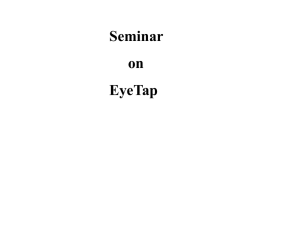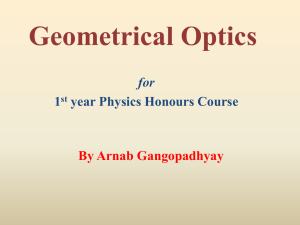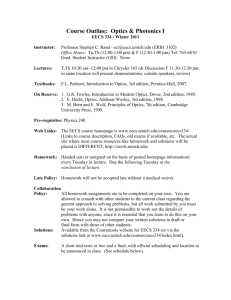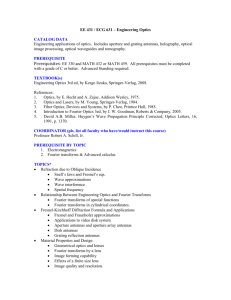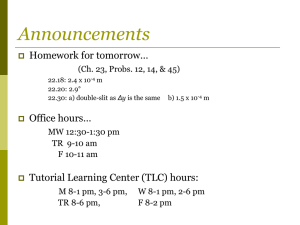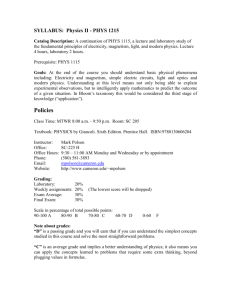geometric optics
advertisement
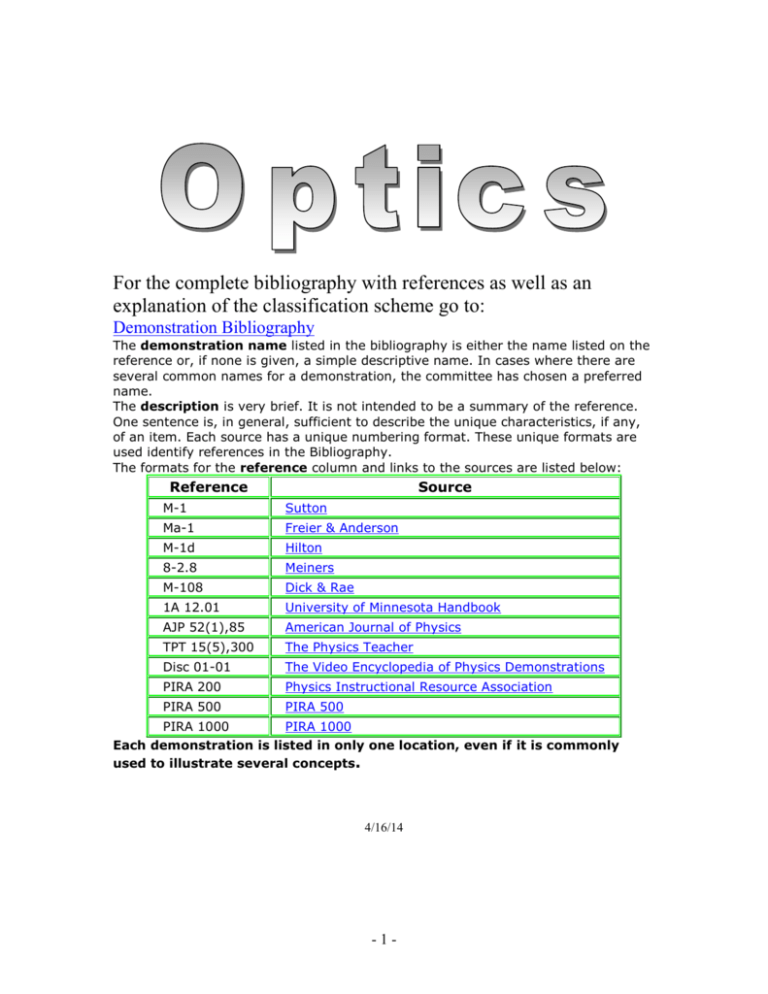
For the complete bibliography with references as well as an explanation of the classification scheme go to: Demonstration Bibliography The demonstration name listed in the bibliography is either the name listed on the reference or, if none is given, a simple descriptive name. In cases where there are several common names for a demonstration, the committee has chosen a preferred name. The description is very brief. It is not intended to be a summary of the reference. One sentence is, in general, sufficient to describe the unique characteristics, if any, of an item. Each source has a unique numbering format. These unique formats are used identify references in the Bibliography. The formats for the reference column and links to the sources are listed below: Reference Source M-1 Sutton Ma-1 Freier & Anderson M-1d Hilton 8-2.8 Meiners M-108 Dick & Rae 1A 12.01 University of Minnesota Handbook AJP 52(1),85 American Journal of Physics TPT 15(5),300 The Physics Teacher Disc 01-01 The Video Encyclopedia of Physics Demonstrations PIRA 200 Physics Instructional Resource Association PIRA 500 PIRA 500 PIRA 1000 PIRA 1000 Each demonstration is listed in only one location, even if it is commonly used to illustrate several concepts. 4/16/14 -1- ...................... 1 12/18/12 .............................................................................Error! Bookmark not defined. GEOMETRIC OPTICS ...................................................................................................... 5 Speed of Light ................................................................................................................. 5 Speed of Light ............................................................................................................. 5 Straight Line Propagation ............................................................................................... 6 Shadows ...................................................................................................................... 6 Chalk Dust .................................................................................................................. 7 Reflection from Flat Surfaces ......................................................................................... 8 Microwave Reflection ................................................................................................. 8 Diffuse and Specular Reflection ................................................................................. 9 Ripple Tank Reflection ............................................................................................. 10 Corner Reflection ...................................................................................................... 11 Angled Mirrors.......................................................................................................... 12 Parallel Mirrors ......................................................................................................... 13 Full View Mirror ....................................................................................................... 14 Mirror Box ................................................................................................................ 15 Reflection from Curved Surfaces.................................................................................. 16 Blackboard Optics - Curved Mirrors ........................................................................ 16 Parallel Lasers and Curved Mirrors .......................................................................... 17 Lamp in the Socket ................................................................................................... 18 Optic Mirage ............................................................................................................. 19 Projected Arrow with Mirror .................................................................................... 20 Concave and Convex Mirrors ................................................................................... 21 Refractive Index ............................................................................................................ 22 Disappearing Beaker ................................................................................................. 22 Mirage with Laser ..................................................................................................... 23 Refraction at Flat Surfaces ............................................................................................ 24 Blackboard Optics - Refraction ................................................................................ 24 Refraction Tank ........................................................................................................ 25 Big Plastic Refraction Tank ...................................................................................... 26 Ripple Tank Refraction ............................................................................................. 27 Seeing a Coin ............................................................................................................ 28 Stick in Water ........................................................................................................... 29 Total Internal Reflection ............................................................................................... 30 Blackboard Optics – Prism, Semicircle .................................................................... 30 Critical Angle in a Refraction Tank .......................................................................... 31 Laser and Fiber Optics .............................................................................................. 32 Laser Waterfall.......................................................................................................... 33 Thin Lenses ................................................................................................................... 34 Blackboard Optics – Thin Lenses ............................................................................. 34 -2- Ripple Tank – Lens Model ....................................................................................... 35 Parallel Lasers and Lenses ........................................................................................ 36 Projected Arrow w/Lens ........................................................................................... 37 Thick Lenses ................................................................................................................. 38 Improving an Image with a Stop ............................................................................... 38 Chromatic and Spherical Aberration ........................................................................ 39 CHOICE MATERIAL GLASS OXIDE ................................................................... 40 Fresnel Lens .............................................................................................................. 41 Optical Instruments ....................................................................................................... 42 Telescope Models ..................................................................................................... 42 Camera Model ........................................................................................................... 43 Lens Combinations ................................................................................................... 44 PHOTOMETRY ............................................................................................................... 45 Luminosity .................................................................................................................... 45 Inverse Square Model ............................................................................................... 45 Inverse Square Law with a Photometer .................................................................... 46 Blackbodies ................................................................................................................... 47 Hole in a Box ............................................................................................................ 47 Black Body Spectrum ............................................................................................... 48 DIFFRACTION ................................................................................................................ 49 Diffraction Through One Slit ........................................................................................ 49 Single Slit and Laser ................................................................................................. 49 Two Finger Slit ......................................................................................................... 50 Ripple Tank – Single Slit .......................................................................................... 51 Microwave Single Slit Diffraction ............................................................................ 52 Diffraction Around Objects .......................................................................................... 53 Arago (Poisson) Spot ................................................................................................ 53 Diffraction around Objects ....................................................................................... 54 Babinet’s Principle .................................................................................................... 55 Pinhole Diffraction.................................................................................................... 56 Square and Rectangular Apertures............................................................................ 57 Zone Plate Lens......................................................................................................... 58 INTERFERENCE ............................................................................................................. 59 Interference From Two Sources.................................................................................... 59 Double Slits and Laser .............................................................................................. 59 Ripple Tank – Two Point .......................................................................................... 60 Microwave Double Slit ............................................................................................. 61 Fresnel Biprism ......................................................................................................... 62 Gratings ......................................................................................................................... 63 Number of Slits ......................................................................................................... 63 Fine Mesh and Laser ................................................................................................. 64 Optical Crystal Set .................................................................................................... 65 Thin Films ..................................................................................................................... 66 Newton's Rings ......................................................................................................... 66 Soap Film Interference .............................................................................................. 67 Air Wedge ................................................................................................................. 68 -3- Step Gauge ................................................................................................................ 69 Interferometers .............................................................................................................. 70 Michelson Interferometer.......................................................................................... 70 Lloyd’s Mirror .......................................................................................................... 71 Optical Resonator...................................................................................................... 72 COLOR ............................................................................................................................. 73 Synthesis and Analysis of Color ................................................................................... 73 Color Box .................................................................................................................. 73 Color Mixing............................................................................................................. 74 Recombining the Spectrum ....................................................................................... 75 Scattering ...................................................................................................................... 76 Sunset ........................................................................................................................ 76 POLARIZATION ............................................................................................................. 77 Dichroic Polarization .................................................................................................... 77 Polaroids on the Overhead ........................................................................................ 77 Polaroid Box ............................................................................................................. 78 Microwave Polarization ............................................................................................ 79 Polarization by Reflection............................................................................................. 80 Brewster's Angle ....................................................................................................... 80 Stack of Plates ........................................................................................................... 81 Circular Polarization ..................................................................................................... 82 Three Polaroids ......................................................................................................... 82 Karo Syrup ................................................................................................................ 83 Faraday Rotation ....................................................................................................... 84 Birefringence................................................................................................................. 85 Calcite and Polaroid on the OHP .............................................................................. 85 Quarter Wave Plate ................................................................................................... 86 Butterfly .................................................................................................................... 87 Polarization by Scattering ............................................................................................. 88 Sunset with Polarizers ............................................................................................... 88 THE EYE .......................................................................................................................... 89 The Eye ......................................................................................................................... 89 Eye Model ................................................................................................................. 89 MODERN OPTICS .......................................................................................................... 90 Holography ................................................................................................................... 90 Holograms ................................................................................................................. 90 Physical Optics.............................................................................................................. 91 Abbe’s Theory of Imaging ........................................................................................ 91 -4- OPTICS 6A01.10 GEOMETRIC OPTICS Speed of Light Speed of Light A pulsed IR laser, a couple of photodiodes and a retro-reflector are used with a fast scope to measure the speed of light. The scope settings are stores in a file on the scope. An IR sensitive card can be used to show the beam. Location: Id2, Fb5 -5- OPTICS 6A02.15 GEOMETRIC OPTICS Straight Line Propagation Shadows Use a point source to cast sharp shadows. Location: Id2 -6- OPTICS 6A02.35 Straight Line Propagation GEOMETRIC OPTICS Chalk Dust Use chalk dust to make a laser beam visible. Location: Ja6 -7- OPTICS 6A10.18 GEOMETRIC OPTICS Reflection from Flat Surfaces Microwave Reflection Reflect a microwave beam off of a metal plate into receiver. Location: Ia7 -8- OPTICS 6A10.20 Reflection from Flat Surfaces GEOMETRIC OPTICS Diffuse and Specular Reflection Use the blackboard optics equipment to show specular reflection off of a mirror then replace the mirror with a sheet of paper. Location: Blackboard Optics Cart -9- OPTICS 6A10.25 Reflection from Flat Surfaces GEOMETRIC OPTICS Ripple Tank Reflection A barrier in a ripple tank reflects plain waves. This can also be done with a point source to illustrate image formation in a plain mirror. Location: Fb4 - 10 - OPTICS 6A10.30 Reflection from Flat Surfaces GEOMETRIC OPTICS Corner Reflection Look at your image in a corner mirror. Also use the TV camera to look into a corner reflector. Location: Id3, Optics Table Cabinet - 11 - OPTICS 6A10.40 Reflection from Flat Surfaces GEOMETRIC OPTICS Angled Mirrors Two hinged mirrors show multiple images of an object placed between them. Location: Id4 - 12 - OPTICS 6A10.45 Reflection from Flat Surfaces GEOMETRIC OPTICS Parallel Mirrors An infinite number of images are formed with a light bulb between parallel mirrors. Location: Id4 - 13 - OPTICS 6A10.50 Reflection from Flat Surfaces GEOMETRIC OPTICS Full View Mirror A mirror is covered with paper so that a person can just see their entire height. Location: IdT - 14 - OPTICS 6A10.65 Reflection from Flat Surfaces GEOMETRIC OPTICS Mirror Box “Pepper’s Ghost”, an old stage illusion. As the light on the subjects face is dimmed another light on a plastic skull brightens causing an apparent metamorphosis. Location: Ja1 - 15 - OPTICS 6A20.10 GEOMETRIC OPTICS Reflection from Curved Surfaces Blackboard Optics - Curved Mirrors Shine parallel beams at convex and concave mirrors. Use the Blackboard optics for two dimensional representations. Location: Blackboard Optics Cart - 16 - OPTICS 6A20.15 Reflection from Curved Surfaces GEOMETRIC OPTICS Parallel Lasers and Curved Mirrors Shine parallel beams at convex and concave mirrors. Location: Ja4, Id5 - 17 - OPTICS 6A20.30 Reflection from Curved Surfaces GEOMETRIC OPTICS Lamp in the Socket The image of a hidden light bulb is projected at the location of an empty socket. Location: IdT - 18 - OPTICS 6A20.35 Reflection from Curved Surfaces GEOMETRIC OPTICS Optic Mirage Two concave mirrors face each other. Images of objects resting on the bottom mirror appear at the center hole of the top mirror. Location: Ja2 - 19 - OPTICS 6A20.40 Reflection from Curved Surfaces GEOMETRIC OPTICS Projected Arrow with Mirror A converging mirror is used to project the image of an illuminated arrow on a screen. Location: Ja2 - 20 - OPTICS 6A20.45 Reflection from Curved Surfaces GEOMETRIC OPTICS Concave and Convex Mirrors Large convex and concave mirrors are shown. Location: Id5 - 21 - OPTICS 6A40.30 GEOMETRIC OPTICS Refractive Index Disappearing Beaker Use Johnson's baby oil or Wesson oil to make a small beaker disappear when immersed. If the beaker has graduations or words they will appear to be floating in the liquid. Location: Ja3 - 22 - OPTICS 6A40.47 Refractive Index GEOMETRIC OPTICS Mirage with Laser A laser beam almost grazing a hot plate will show a deflection when the plate is turned on. In the arrangement shown the laser spot on the scale moves up about 2 cm as the plate heats up. It takes a few minutes. Location: Ja6, Gb2 - 23 - OPTICS 6A42.10 GEOMETRIC OPTICS Refraction at Flat Surfaces Blackboard Optics - Refraction The light source can be rotated through 270 degrees to show refraction and total internal reflection for both air/plastic and plastic/air interfaces. One can also use a rectangular prism (not shown but in the supplied BBO equipment) to show refraction and internal reflection. Location: Blackboard Optics Cart - 24 - OPTICS 6A42.20 Refraction at Flat Surfaces GEOMETRIC OPTICS Refraction Tank The light source can be rotated through 270 degrees to show refraction and total internal reflection for both air/plastic and plastic/air interfaces. Also can be done with an aquarium tank, water and a laser. Location: Ja3, Ja6 - 25 - OPTICS 6A42.22 Refraction at Flat Surfaces GEOMETRIC OPTICS Big Plastic Refraction Tank The light source can be rotated through 270 degrees to show refraction and total internal reflection for both air/plastic and plastic/air interfaces. Be careful using the bright (20 mw) green laser. Location: PbT, Jd1 - 26 - OPTICS 6A42.35 Refraction at Flat Surfaces GEOMETRIC OPTICS Ripple Tank Refraction The wave velocity over a shoal is smaller than that over deeper water and thus refraction of the ripples occurs over the plastic shoal. Location: Fb4 - 27 - OPTICS 6A42.40 Refraction at Flat Surfaces GEOMETRIC OPTICS Seeing a Coin Pour water in a cup until a coin at the bottom (use double stick tape to hold it in place) previously hidden by the side is visible. Location: Ja3 - 28 - OPTICS 6A42.45 Refraction at Flat Surfaces GEOMETRIC OPTICS Stick in Water A stick appears bent when inserted into water. Location: Ja4 - 29 - OPTICS 6A44.10 GEOMETRIC OPTICS Total Internal Reflection Blackboard Optics – Prism, Semicircle Rotate the semicircular slab of Plexiglas with the light ray entering the exiting through the curved surface. Rotate the semicircular slab until the critical angle is reached and total internal reflection is obtained. Location: Blackboard Optics Cart - 30 - OPTICS 6A44.20 Total Internal Reflection GEOMETRIC OPTICS Critical Angle in a Refraction Tank A beam in a tank of water is rotated until there is total internal reflection at the surface. Location: Ja3, Ja6 - 31 - OPTICS 6A44.40 Total Internal Reflection GEOMETRIC OPTICS Laser and Fiber Optics You are provided with a Plexiglas rod, Plexiglas curly Q and a section of fiber optic cable. Hold their ends in the beam near the laser. Vary the number of reflections in the rod by changing the angle. Location: Blackboard Optics Cart, Ja4, Ja6 - 32 - OPTICS 6A44.45 Total Internal Reflection GEOMETRIC OPTICS Laser Waterfall Shine a laser down the center of a nozzle and it follows the water stream. Location: Dd6, Ja6 - 33 - OPTICS 6A60.10 GEOMETRIC OPTICS Thin Lenses Blackboard Optics – Thin Lenses Blackboard optics are used with convex and concave thin lens elements Location: Blackboard Optics Cart - 34 - OPTICS 6A60.15 Thin Lenses GEOMETRIC OPTICS Ripple Tank – Lens Model Refraction due to depth differences over a lens shaped area in the ripple tank. Location: Fb4 - 35 - OPTICS 6A60.20 Thin Lenses GEOMETRIC OPTICS Parallel Lasers and Lenses Parallel lasers are passed through converging and diverging lenses. Chalk dust illuminates the beams. Location: Id1, Ja4 - 36 - OPTICS 6A60.31 Thin Lenses GEOMETRIC OPTICS Projected Arrow w/Lens Turn on the light bulb. Move the light bulb to focus the image on the side wall. The focal lengths are marked on the lenses. Show the effect of aperture size on the sharpness on the focus by placing different sized stops in front of the lens. Location: Id1, Jd3 - 37 - OPTICS 6A65.10 GEOMETRIC OPTICS Thick Lenses Improving an Image with a Stop Turn on the light bulb. Move the light bulb to focus the image on the side wall. The focal lengths are marked on the lenses. Show the effect of aperture size on the sharpness on the focus by placing different sized stops in front of the lens. Use the thick, short focal length lens. Location: Ja5, Jd3 - 38 - OPTICS 6A65.24 Thick Lenses GEOMETRIC OPTICS Chromatic and Spherical Aberration Use diaphragms with central, annular, and other openings to show spherical and chromatic aberration. Location: Ja6, Jd3 - 39 - OPTICS 6A65.56 Thick Lenses GEOMETRIC OPTICS CHOICE MATERIAL GLASS OXIDE CHOICE MATERIAL GLASS OXIDE is viewed through an acrylic rod or a plastic tube filled with water. Location: Ja3 - 40 - OPTICS 6A65.70 Thick Lenses GEOMETRIC OPTICS Fresnel Lens Show some Fresnel Lenses and a model of them. Location: Ja5, Jd3 - 41 - OPTICS 6A70.20 GEOMETRIC OPTICS Optical Instruments Telescope Models Blackboard optics illustrations of a Keplerian telescope and a Gallilean telescope. Location: Blackboard Optics Cart - 42 - OPTICS 6A70.30 Optical Instruments GEOMETRIC OPTICS Camera Model Blackboard optics illustration of a camera. Location: Blackboard Optics Cart - 43 - OPTICS 6A70.45 Optical Instruments GEOMETRIC OPTICS Lens Combinations Set up some optical systems with more than one lens. Use the TV camera and screen to show intermediate images. It is helpful to use a dimmer on the source object box to keep the TV image from being washed out. Location: Id4, Jd3 - 44 - OPTICS 6B10.15 PHOTOMETRY Luminosity Inverse Square Model A point source casts a shadow from a square frame. A screen four times the area is placed twice as far from the source as the frame. The light going through the frame just fills the screen. Location: JaT, Ja6, Jd3 - 45 - OPTICS 6B10.20 Luminosity PHOTOMETRY Inverse Square Law with a Photometer A photometer is used to measure the intensity at various distances from a point source. Adjust the sensitivity to read 10 on the relative intensity scale when the sensor is 20 cm from source. Then read the values at 40 and 80 cm. Location: Jb1, Jd3 - 46 - OPTICS 6B40.20 PHOTOMETRY Blackbodies Hole in a Box A box that is painted black has a hole in a hinged door. The hole appears blacker than the box, When the door is opened, you see the box is actually painted white on its inside surfaces. Use an infrared camera to look at a hole in a heated aluminum block (100 C). Location: Jb2, Fc5, FLIR Cabinet - 47 - OPTICS 6B40.40 Blackbodies PHOTOMETRY Black Body Spectrum A spectrometer and bolometer connected to Science Workshop is used to record the spectrum from an incandescent bulb at various temperatures. Location: Science Workshop Cabinet, Optics Table Cabinet - 48 - OPTICS 6C10.10, 6C10.15 DIFFRACTION Diffraction Through One Slit Single Slit and Laser Turn on the laser. The pattern appears on the wall. The slit widths are printed on the wheel. To select a different slit, turn the wheel. We also have the Cornell slitfilm card, which includes a slit of gradually increasing width. There is also a variable slit one can also use to “choke” the laser beam. Use the 40 mW green diode laser, shimmed to the proper beam height. CAUTION: the undiffracted beam is bright enough to be harmful. Location: Ja6, Jb3 - 49 - OPTICS 6C10.20 Diffraction Through One Slit DIFFRACTION Two Finger Slit Have each student look at a vertical filament lamp through the slit formed by holding two fingers closely together. Location: Jd3 - 50 - OSCILLATIONS AND WAVES 3B50.10 WAVE MOTION Interference and Diffraction Ripple Tank – Single Slit Set up the ripple tank with a plane wave source and a single slit. Location: Fb4 - 51 - OPTICS 6C10.50 Diffraction Through One Slit DIFFRACTION Microwave Single Slit Diffraction 3 cm microwave and a single slit. Location: Ia7 - 52 - OPTICS 6C20.10 DIFFRACTION Diffraction Around Objects Arago (Poisson) Spot Shine an expanded laser beam at a ball bearing and look at the diffraction pattern. Location: Jb3, Ja6 - 53 - OPTICS 6C20.15 Diffraction Around Objects DIFFRACTION Diffraction around Objects Diffraction of a divergent laser beam around a razor blade or needle. Location: Jb3, Ja6 - 54 - OPTICS 6C20.20 Diffraction Around Objects DIFFRACTION Babinet’s Principle Diffraction of a divergent laser beam around a thin line (0.08 mm) is compared to diffraction by a slit of the same size. Use the brighter laser on the slit. The wheel has both the individual line and slit that you can use by turning the wheel. Alternatively, there is a slide on the wheel that has the slit and line side by side (move the whole wheel holder from side to side to go from one to the other). Use the 40 mW green diode laser, shimmed to the proper beam height. CAUTION: the undiffracted beam is bright enough to be harmful. Location: Jb3, Ja6 - 55 - OPTICS 6C20.30 Diffraction Around Objects DIFFRACTION Pinhole Diffraction Shine a laser beam through pinholes of various sizes. Use the 40 mW green diode laser, shimmed to the proper beam height. CAUTION: the undiffracted beam is bright enough to be harmful. Location: Jb3, Ja6 - 56 - OPTICS 6C20.35 Diffraction Around Objects DIFFRACTION Square and Rectangular Apertures Shine a laser beam through a square (0.16 mm x 0.16 mm) or rectangular aperture (0.16 mm x 0.08 mm) aperture. The Mounting hardware for the apertures is in the Newport Holography kit. Location: Jb3, Ja6 - 57 - OPTICS 6C20.40 Diffraction Around Objects DIFFRACTION Zone Plate Lens Use a zone plate. The source is a spatially filtered diverging beam. Also place a zone plate on the overhead projector to show the center is an opaque spot (note we also have one that is not opaque in the center). Location: Jb3, Ja6 - 58 - OPTICS 6D10.10 INTERFERENCE Interference From Two Sources Double Slits and Laser Turn on the laser. The pattern appears on the wall. The slit widths and spacings are printed on the wheel. To select different slits, turn the wheel. There is a continuously variable double slit that varies the slit spacing on the wheel. We also have the Cornell slitfilm card, which includes double slits of increasing width and spacing. Use the 40 mW green diode laser, shimmed to the proper beam height. CAUTION: the undiffracted beam is bright enough to be harmful. Location: Jb4, Ja6 - 59 - OSCILLATIONS AND WAVES 3B50.20 WAVE MOTION Interference and Diffraction Ripple Tank – Two Point Set up the ripple tank with a double point source. Location: Fb4 - 60 - OPTICS 6D10.20 Interference From Two Sources Microwave Double Slit 3 cm microwave and a double slit. Location: Ia7 - 61 - DIFFRACTION OPTICS 6D10.41 Interference From Two Sources DIFFRACTION Fresnel Biprism A spatially filtered diverging beam illuminates a Fresnel biprism. A pattern similar to a double slit is produced. Location: Jb4, Ja6, Optics Table Cart - 62 - OPTICS 6D20.10 INTERFERENCE Gratings Number of Slits Turn on the laser. The pattern appears on the wall. The slit widths, numbers and spacings are printed on the wheel. To select different slits, turn the wheel. View the results of the interference pattern on the wall. The lights in the room may need to be darkened. Use the 40 mW green diode laser, shimmed to the proper beam height. CAUTION: the undiffracted beam is bright enough to be harmful. Location: Jb4, Ja6 - 63 - OPTICS 6D20.55 Gratings INTERFERENCE Fine Mesh and Laser Shine a laser through a fine mesh and observe the patterns. Location: Jb4, Ja6 - 64 - OPTICS 6D20.57 INTERFERENCE Gratings Optical Crystal Set Seven sequences of 2x2 slides used in the simple Laue approach to diffraction by crystals. Location: Jb4, Jd2 - 65 - OPTICS 6D30.10 INTERFERENCE Thin Films Newton's Rings Turn on the light. The interference pattern is projected onto the side wall. Change the pattern by tightening a screw on the edge of the glass disk. Location: Id1, Jb4, Jd3 - 66 - OPTICS 6D30.20 Thin Films INTERFERENCE Soap Film Interference Turn on the light. Dip the wire frame into the soap solution and secure with the clip. Adjust the angle until the pattern appears on the side wall. Location: Id1, Jb4, Jd3 - 67 - OPTICS 6D30.30 INTERFERENCE Thin Films Air Wedge A sodium lamp illuminates two plates of glass (in the picture two quartz surface plates are shown). Compare with a piece of glass that is not an optical flat. Location: Jb3, Ka2 - 68 - OPTICS 6D30.55 INTERFERENCE Thin Films Step Gauge Thin films of barium stearate, from 2 x10-6 to 16 x10-6 inches in microinch increments are deposited on a glass plate. The steps reflect a vivid series of interference colors when illuminated by white light. Location: Jb4 - 69 - OPTICS 6D40.10 INTERFERENCE Interferometers Michelson Interferometer Turn on the laser. Read the initial position of the micrometer. Count the number of fringes while turning the micrometer slowly in one direction only. Read the final position. This can also be done with white light. A spatial filter is used to create a clean, diverging beam. Location: Optics Table Cabinet, Jb5, Ja6 - 70 - OPTICS 6D40.27 INTERFERENCE Interferometers Lloyd’s Mirror The laser is aligned so that the beam grazes the surface of the glass plate. Two spots are seen on a distant screen, one from the light passing directly over the plate and the other from the light reflected from the plate. As the plate is raised into the beam, the spot of light from the reflection will lower and merge with the spot that passes directly over the plate. As it does, an interference pattern will appear. Location: Optics Table Cart, Ja6, Jc3 - 71 - OPTICS 9B62.11 INTERFERENCE Interferometers Optical Resonator Light from a laser is directed down the optical cavity of an old laser tube. The cavity acts as an optical resonator and as the exciting laser warms up, its frequency slews through a spectrum of frequencies. As the frequencies match resonate frequencies in the old tube (it can be thought of as a Fabry Perot interferometer), light is transmitted through it and shows up as a spot on a screen placed down beam from the exit side. Various modes can be observed as the exciting lasers frequency changes. Location: Ia1, Ja6 - 72 - OPTICS 6F10.10 COLOR Synthesis and Analysis of Color Color Box Three spot lights with color filters are used to project colored spots on a screen. The spots overlap to show color mixing. Colorful shadows can be cast as well. Location: Jb6 - 73 - OPTICS 6F10.14 Synthesis and Analysis of Color COLOR Color Mixing Use an old LCD projector to split a white beam of light into RGB and then recombine it. Location: Jb6 - 74 - OPTICS 6F10.30 Synthesis and Analysis of Color COLOR Recombining the Spectrum Recombine the spectrum after passing through a prism to get white light or remove a color to get the complement. Location: Ib1, Jb3, Jc1 - 75 - OPTICS 6F40.10 COLOR Scattering Sunset A beam of light shines through a circular slide on the overhead projector and then through one liter of water and onto the side wall. Add a few drops of Pinesol (cedarwood oil in alcohol or Lysol) to the water and stir with the stick. The "sun" will begin to turn yellow. To increase the scattering to an orange sun, add more Pinesol. It takes about 15 minutes to fully achieve the effect. Use the Polaroid film to show the scattered blue light is polarized (it becomes less so as you get double scattering). Location: Jc2 - 76 - OPTICS 6H10.10 POLARIZATION Dichroic Polarization Polaroids on the Overhead You get two sheets of Polaroid and a pair of Polaroid sunglasses. Rotate one on the Polaroids or the sunglasses. Location: Jc3, Ja5 - 77 - OPTICS 6H10.12 Dichroic Polarization POLARIZATION Polaroid Box An arrangement of cross polarizers makes it appear that there is a solid barrier inside a box. Jc3 - 78 - OPTICS 6H10.20 Dichroic Polarization POLARIZATION Microwave Polarization Hold a grid of parallel wires in a microwave beam and rotate the grid. Location: Ia7 - 79 - OPTICS 6H20.10 POLARIZATION Polarization by Reflection Brewster's Angle Light is reflected from a sheet of black glass onto the wall. Rotate a sheet of Polaroid in the path of the reflected light. We set the light at Brewster's Angle. Vary the incident angle by rotating the light. A metal triangle can be used to set the incident light back to Brewster's Angle. Location: Jc3, Jd3 - 80 - OPTICS 6H20.40 Polarization by Reflection POLARIZATION Stack of Plates A stack of glass plates at 57 degrees will transmit and reflect light that is cross polarized. In this apparatus, the black mirror serves as an analyzer for the transmitted beam and when the ray reflected off of it is in the same direction as the rays reflected off of the stack of plates, the intensity is low because the plane of polarization of the transmitted ray is normal to a line in the plane of the black glass; however, if you rotate the black mirror 90 degrees so the reflected beam is normal to the direction of the rays reflected off of the stack, then the plane of polarization of the transmitted ray is in the plane of the black glass and the ray is more intense. Use the green, unpolarized laser as the light source. Location: Ja6, Jc3 - 81 - OPTICS 6H30.10 POLARIZATION Circular Polarization Three Polaroids Three sheets of Polaroid are provided with an overhead projector. Also shown in the photograph is a circular polarizer. Location: Jc3 - 82 - OPTICS 6H30.40 Circular Polarization POLARIZATION Karo Syrup Place the Karo syrup between two circular polarizers. Place the light source behind the rear polarizer and turn the lamp on. Rotate the front polarizer and watch the syrup change colors. Use a point source with a diffuser. The polarization axis finder (disk) is added for fun. Location: Jc2, Jc4 - 83 - OPTICS 6H30.80 Circular Polarization POLARIZATION Faraday Rotation A TGG (Terbium Gallium Garnet) glass sample is placed in a polarimeter and illuminated with one of 3 lasers (405 nm, 532 nm and 605 nm). The polarimeter is adjusted for minimum throughput. A magnetic field is applied (0.13 T) and the Faraday rotation is observed by finding the new minimum. - 84 - OPTICS 6H35.15 POLARIZATION Birefringence Calcite and Polaroid on the OHP A calcite rhomb is placed on an overhead projector with a slide underneath. The double image can then be seen and manipulated with a polarizer. Location: Jc4 - 85 - OPTICS 6H35.40 POLARIZATION Birefringence Quarter Wave Plate Show two plates with attached polarizers and the Magic glass trick wherein light appears to go through one way but not the reverse path (it’s a trick). One can also do this with one plate/polarizer by looking through it at a mirror and then flipping 180 degrees about a horizontal axis and looking again. Location: Jc3 - 86 - OPTICS 6H35.53 Birefringence POLARIZATION Butterfly Mica, cellophane, butterfly slide, etc. are placed between crossed polarizers. Location: Jc3 - 87 - OPTICS 6H50.10 POLARIZATION Polarization by Scattering Sunset with Polarizers Use a sheet of Polaroid to check the polarization of scattering from a beam of light passing through a tank with scattering particles. Location: Jc2 - 88 - OPTICS 6J10.10 THE EYE The Eye Eye Model The standard take-apart eye model. A Blackboard optics two dimensional version is also shown in the photograph. Location: Blackboard Optics Cart, Jc5 - 89 - OPTICS 6Q10.10 MODERN OPTICS Holography Holograms Use a laser with a spatial filter to illuminate the hologram. Location: Ja6, Jc6, Optics Table Cart - 90 - OPTICS 6Q20.10 MODERN OPTICS Physical Optics Abbe’s Theory of Imaging A laser beam illuminates an “Optical Crystal” (a geometric array of small characters). You see the diffraction pattern consisting of the body factor convolved with the form factor. Insert a lens and you see its Fourier transform, the real image of the Optical Crystal Location: Jb4, Jd2 - 91 -

